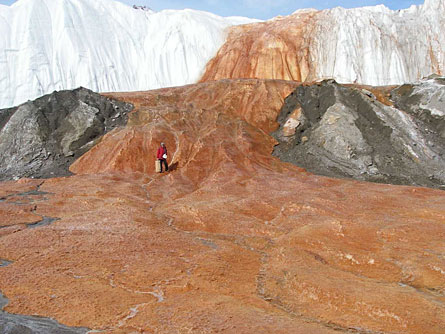Antarctic ecosystem holds unusual microbes
Long isolated, they thrive in dark, salty water and breathe iron
A frigid, sulfate-rich pool of anoxic, hypersaline water that hasn’t seen the sun since it was capped by a 400-meter-thick Antarctic glacier at least 1.5 million years ago is host to microbes that derive energy by breathing iron scraped from bedrock.

“This briny pond is a unique sort of time capsule,” says Jill Mikucki, a geomicrobiologist now at Dartmouth College. “I don’t know of any other environment quite like this on earth.”
The long-isolated ecosystem, which Mikucki and her colleagues describe in the April 17 Science, lies about 4 kilometers upstream from the snout of a glacier in one of Antarctica’s McMurdo Dry Valleys. The team analyzed samples of water that occasionally seep from the rust-stained face of that glacier at a site aptly named Blood Falls.
Chemical analyses by Mikucki, and her team suggest that the water comes from the remnants of a lake that formed when sea levels dropped worldwide between 1.5 million and 2 million years ago. Later, after much of the water had evaporated, the salty lake was smothered by an advancing glacier. The cold, clear water now seeping from Blood Falls “smelled like the ocean when I got the samples” and is about 2.5 times as salty as the ocean, says Mikucki, who conducted the research while at Harvard University.
The briny samples include no dissolved oxygen and little organic matter, but plenty of dissolved iron — an element that quickly oxidizes to form blood-red rust when the seepage hits the air. The microbes in the seepage are similar to some species found in modern-day marine environments, the researchers note. And the microbes gain their energy by metabolically transferring electrons from the water’s dissolved sulfates to its iron, which is liberated from the bedrock by the scraping of the glacier, says Mikucki.
“This is a great example of electron shuttling sustaining an ecosystem,” says Dianne K. Newman, a geobiologist at MIT.
Unlike most modern marine microbes, however, those long-trapped beneath the Antarctic glacier don’t chemically reduce sulfates in the water all the way to sulfides. Instead, the set of energy-producing metabolic reactions stops at sulfites — a trick never before seen in lab-bound organisms, the researchers note. The team’s analyses suggest that the microbes don’t have the genetic capability to transform sulfites into sulfides.
That metabolic trick “was the one that raised my eyebrows the most,” says Tim Lyons, a biogeochemist at the University of California, Riverside. The dearth of dissolved organic material in the seepage, as well as the apparent lack of a gene that enables sulfite-to-sulfide metabolic reactions, is probably what prevents the organisms’ production of sulfide, he notes.
Although similar reactions have been seen in the lab, they haven’t been noted in nature, says Bernhard Schink, a microbiologist at the University of Constance in Germany. In this case, he notes, they’re easy to see because of the simplicity of the ecosystem. “I’m rather convinced this is a common process … and far more common in sediments and other anoxic environments than is now recognized,” he adds.







